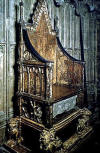|

by
Christopher L. C. E. Witcombe
Stones of various kinds and
sizes have been invested with sacredness from the earliest times. The
worship of stones can be found in most ancient cultures, while sacred stones
can be found in most of the world's religions.
According to Pausanias (VII, 24. 4), in olden times all the Greeks
worshipped unwrought stones instead of images and describes thirty square
stones near a spring sacred to Hermes at Pharae in
Greece.
Beginning as early as 5000 BCE, large stones (megaliths - Greek mega, great,
and lithos, stone), either unwrought or roughly worked were erected across
prehistoric Europe to stand in lines or in circles (such as at
Stonehenge in England), or otherwise arranged in conjunction with
earthworks usually identified as burial mounds (such as at Newgrange
in Ireland). Little is known the purpose or meaning of these megalithic
constructions, but it is universally agreed that they mark or embellish a
sacred place in the landscape.
Examples of megalithism can also found in countries around the world, such
as the Beforo monument near Bouar in the Central African
Republic, the Tatetsuki stone circles standing the summit of a
tumulus at Okayama in Japan, and the moai statues on
ceremonial platforms on
Easter Island.
The moving and arranging of massive stones into a building or some other
configuration in a sacred context also characterizes many early cultures
around the globe, from the Inca in South America, to the Egyptians and
Mycenaeans.
|
Smaller individual
stones can also become invested with the sacred. The Stone
of Scone, also known as the Coronation Stone or
the Stone of Destiny, until very recently rested on a
shelf beneath the seat of the Coronation Chair in Westminster
Abbey in London (it has now been returned to Scotland. It is
said that the stone could identify a rightful ruler of the
country by emitting a loud cry. Since the 13th century, every
British king or queen (except for the first Mary) has been
crowned monarch while seated in this chair over this stone. The
stone had been brought to London by order of King Edward I
from Scotland in 1297. In Scotland the stone had been kept at
Scone Palace in Perthshire where 34 successive Scottish kings
had been crowned while seated upon it. |
 |
According to tradition, the
stone had been brought to Scotland from Ireland where, up to that time the
newly crowned kings of Ireland had been crowned upon it on the Hill of Tara.
Legend further explains that the stone had come to Ireland from Judah in the
4th century BCE when the daughter of the last king of Judah married into the
Irish royal family. Previously, the stone had been kept in the Temple
of Jerusalem when the kings of Judah had been crowned upon it.
Traditionally, the stone is believed to be that which Jacob used as a pillow
when he had his dream of angels at Bethel.
Another example of a holy stone is the very sacred Black Stone
(reddish black, with some red and yellow particles) inside the holy shrine
of the Ka'ba at Mecca. It is thought that the Black Stone, now
in pieces (three large parts, with smaller fragments which are tied together
with a silver band), may be a meteor, or a piece of lava, or a piece of
basalt. Its original diameter is estimated to have been 30 cm. Besides the
Black Stone, built into the western corner of the Ka'ba
is less sacred Stone of Good Fortune.
Stones and rocks in Japan were initially seen as symbols of mononoke
(supernatural forces which permeate matter and space). Later, an abstract,
undifferentiated mononoke was replaced by more definite
animistic deities which resided in the stones and rocks. These rock abodes
are called iwakura. All over the precinct of the Shrine at
Ise are rocks and stones which are venerated as the abodes of
deities, such as the subsidiary shrine at the Naiku called
Takimatsuri-no-kami.
Elsewhere in Japan are many
stones and stone arrangements representing the male and female principle,
such as the stone circle at Oyu in Akita Prefecture in
Northeastern Japan. The emotional attachment to natural stones, originally
religion-inspired, has persisted in Japan and is manifest today in the
creation of richly symbolic and spiritual stone gardens.
|
